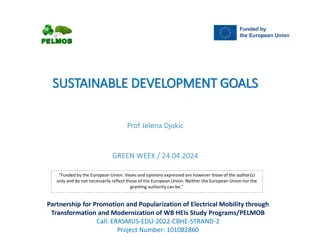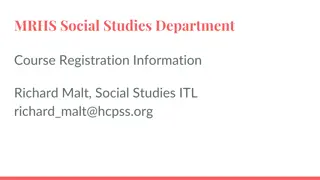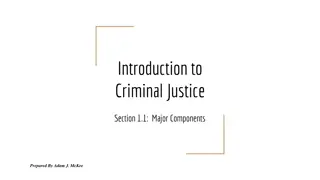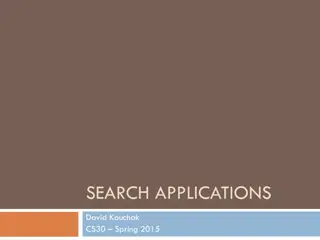Overview of Higher Education in the United States
Martha C. Merrill, Ph.D., discusses the development and structure of higher education in the United States. Topics include the evolution from an elite to mass to universal system, the influence of the US Department of Education, accreditation processes, and the differentiation of institutions to meet diverse student needs.
Download Presentation

Please find below an Image/Link to download the presentation.
The content on the website is provided AS IS for your information and personal use only. It may not be sold, licensed, or shared on other websites without obtaining consent from the author. Download presentation by click this link. If you encounter any issues during the download, it is possible that the publisher has removed the file from their server.
E N D
Presentation Transcript
Martha C. Merrill, Ph.D. Associate Professor of Higher Education Administration Kent State University , USA
The US Ph.D. developed to meet the needs of the US 3 important factors: Social mobility Massification Government does not control curriculum
Your social status at birth does not determine what you will achieve in life Education has been a way of changing social status.
Martin Trow: elite to mass to universal Elite = 15% or less attend HE Mass = 15% to 50% Universal = more than 50% The US was the first country to achieve massification
If a large proportion of the population attends higher education, then students have a diversity of needs. To meet the diversity of needs, the system differentiates. This is why the US has: Community colleges Liberal arts colleges Research universities
The US Department of Education may influence social policy Land-grant College Act Federal financial aid But it does not control curriculum Committees of faculty and professional societies decide curricula
Higher education institutions award their own degrees Program content can vary from one HEI to another Quality is assured by accreditation Institutional (regional) accreditation Program accreditation
Accreditation is carried out by independent agencies, not by the government. More information: Council on Higher Education Accreditation (www.chea.org) Non-governmental quality assurance is a requirement of the Bologna Process.
The Ph.D., unlike the kandidat nauk and doktor nauk, is awarded by an institution, not by the government. The Ph.D. is a coherent program of: Required and elective courses Including courses in research design Comprehensive exams Dissertation
Graduate Handbook for the College and Graduate School at Kent State University (38 pages; doctoral requirements start on page 15) http://www.kent.edu/ehhs/ogs/upload/msh_ graduate_handbook_071211.pdf HIED doctoral Plan of Study http://www.kent.edu/ehhs/hied/degrees/upl oad/phd_plan_of_study_2012-6-2.pdf
Usually takes about three years 60 US credits 120 ECTS is typical Usually core requirements for all students Electives depending on specialization Research courses Kent State HIED program: 15 credits of research (5 courses) Students have a faculty advisory committee from the beginning of the program.
To synthesize the course work into a coherent view of the field or the profession Can take many different forms Usually a written component and an oral defense In the US, no one is a designated opponent. All professors can challenge you and support you.
Student selects dissertation committee, within certain parameters. Dissertation proposal Dissertation
Chair Second person from the department or school Sometimes an additional person from the department of school, or a methodology person External person Kent State: Graduate Faculty Representative Each program and university will have slightly different requirements. Kent State: Qualifications for Graduate Faculty Status
Must be formally approved by the committee and administrators (at KSU, by the Associate Dean) Usually the first three chapters of the dissertation Introduction significance research question conceptual framework Literature review Methodology
Research QUESTION that the student wants to answer Conceptual or theoretical framework: what are the theoretical perspectives or assumptions in which the question is grounded?
Relevant literature from a diversity of fields A has studied this, B has studied that, but no one has studied my exact question The dissertation must be original research that contributes new knowledge to the field.
What is the best research design to answer my question? Quantitative, qualitative, mixed methods Many specific forms within these categories The best research method depends on the question you want to answer.
If your study involves talking to or surveying or observing or in any way interacting with people, your study must undergo Human Subjects Review by an Institutional Review Board. You must show that you are not harming your subjects. You can not begin your research until it has been approved by the Institutional Review Board.
After the proposal has been approved by the committee and the research has been approved by the Institutional Review Board, the research can start. The student usually will make some changes to the first three chapters, particularly the literature review, as the research progresses. Major changes require committee approval, and changes involving human subjects require IRB approval.
Presentation of the results of the research Analyzed with the original research question in mind
What is important in the findings? What was an unexpected finding? What are the limitations of the study? To what groups does it apply and not apply, and why? What additional issues are raised by this research? What questions should future researchers try to answer?
The committee is involved throughout the process. In some programs, the student works closely with the chair; in other programs, the student is in close touch with all members of the committee.
The student circulates copies of the dissertation to all committee members usually at least a month in advance of the defense. The committee reads the full dissertation and determines if the student is ready for the defense. The oral defense usually lasts 1 to 2 hours. Often minor revisions are needed.
Most dissertations are published online through Pro Quest s Dissertation Abstracts International. http://www.umi.com/en- US/catalogs/databases/detail/dai.shtml University libraries sometimes keep hard copies.
Committee members have Graduate Faculty Status Graduate Faculty Representative (Kent State) Signatures (committee members, deans) Dissertation availability through Pro Quest Program accreditation Institutional accreditation
Some classic authors: Robert Bogdan & Sari Knopp Bickel Cliff Conrad (ASHE Reader Series) http://www.ashe.ws/?page=173 John Cresswell Sharan Merriam Lawrence Neumann
Internationally recognized Coherent program of coursework, research, and synthesis Original scholarship required Individual choice of topic, research methods Mentor support Publication through Pro Quest easily accessible
Some programs and institutions awarding the Ph.D. are more recognized than others. Some programs prepare students only for faculty careers and not for other kinds of 21st century careers. One long monograph may not be the best preparation in all fields.
Council on Higher Education Accreditation www.chea.org Kent State University, College and Graduate School of Education, Health, and Human Services. (2011) Graduate Handbook Kent, OH: Author http://www.kent.edu/ehhs/ogs/upload/msh_gra duate_handbook_071211.pdf Kent State University, Higher Education Administration Program (2012) Plan of Study for the Ph.D. http://www.kent.edu/ehhs/hied/degrees/upload /phd_plan_of_study_2012-6-2.pdf
Thurgood, L. , Golloday, M. J., and Hill, S.T. (2006, June) US Doctorates in the 20thCentury Washington, DC: National Science Foundation Trow, M. (2000) From Mass Higher Education to Universal Access: The American Advantage. Berkeley: University of California Berkeley Center for the Study of Higher Education Occasional Paper Series. http://cshe.berkeley.edu/publications/docs/PP.Trow. MassHE.1.00.pdf Wendler, C., Bridgeman, B., Cline, F., Millett, C., Rock, J., Bell, N., and McAllister, P. (2010). The Path Forward: The Future of Graduate Education in the United States. Princeton, NJ: Educational Testing Service























